HP w2408: A "New" Twist on 24" LCDs
by Jarred Walton on December 21, 2007 5:00 AM EST- Posted in
- Displays
Appearance and Design
Where the HP w2408 really makes a statement is in its external appearance. This is more or less identical to what we saw on the w2207, but we still like the design. The w2408 comes with 4.5" of height adjustment, and in the lowered state the bottom of the LCD panel rests on the thin base stand. The LCD panel and the surrounding border come with a glossy finish, with matte silver and black surfaces on the remainder of the display.
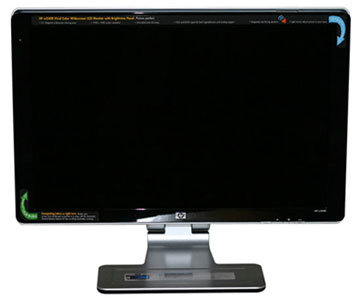 |
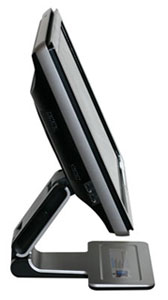 |
At the bottom right of the LCD, we get the usual buttons for accessing the on-screen display (OSD). The left button brings up the OSD, and then the other buttons become active for navigating the menus. Prior to entering the menu, the right button executes the auto adjustment function (for use with analog connections), the second button brings up volume control, and the third button cycles between five display modes (movie, photos, games, text, and user defined). You can customize these five display modes individually, should you so desire, providing a quick shortcut to various settings; the names are mostly there for the default settings. The power button is on the top of the chassis and glows a faint orange/blue depending on whether the display is on or in standby mode.
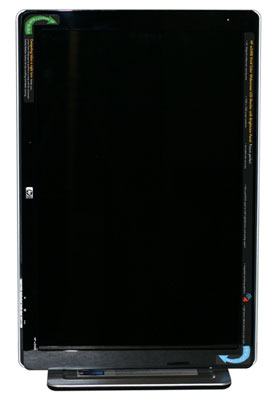 |
Unlike many of the less expensive 24" LCDs, you can pivot the w2408 into portrait mode, which some people find useful for reading long web pages or documents. When in portrait mode, you have to raise the panel to its maximum height.
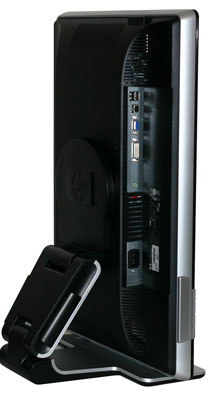 |
The input ports all face downwards on the back of the display. As mentioned, the w2408 comes with DVI and VGA inputs. Additionally, there is a USB input port, an audio jack, and two USB output ports. All of the necessary cables come with the LCD, though you should probably ditch the audio cord if fidelity is of any concern - the sound quality is bad at best, and not very loud even at maximum volume.
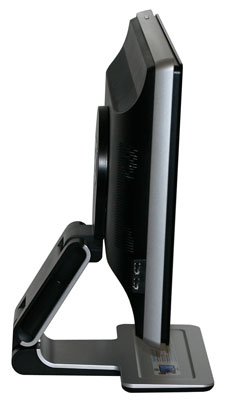 |
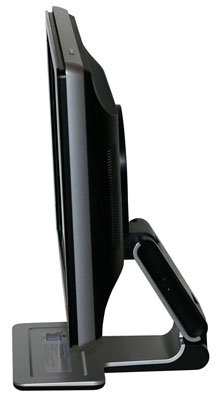 |
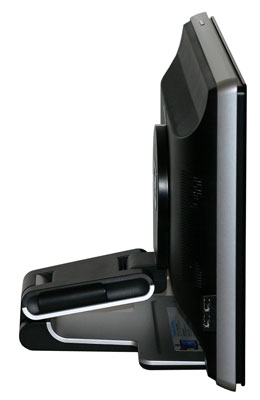 |
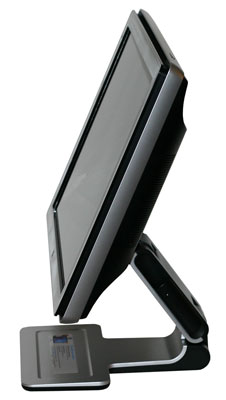 |
Looking at the profile of the LCD, we see the range of motion that the base stand offers. Two more USB ports are on the left side, with no noteworthy features on the right side. Like other HP LCDs, the w2408 supports HP's Easy Clip accessories. HP sent us a webcam that attaches to the top of the display, and this time the drivers worked with Vista. Quality was fine though not noticeably better than the other webcams; unfortunately, the drivers under Windows Vista still appear to be immature -- attempting to adjust settings frequently caused video chat applications to crash.
We will and this section with screenshots of the various OSD (On-Screen Display) menus. The various options should be self-explanatory.
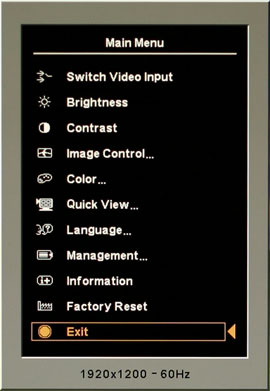
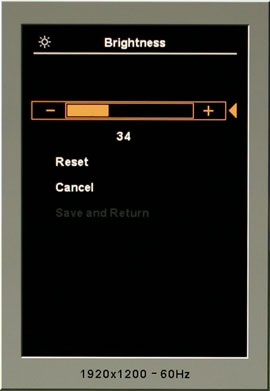
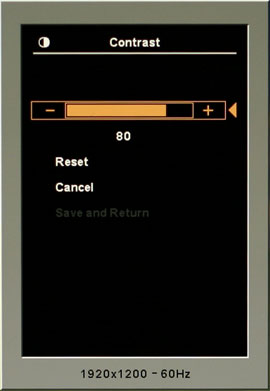

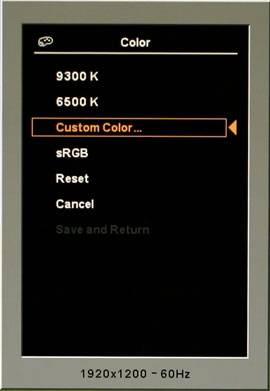
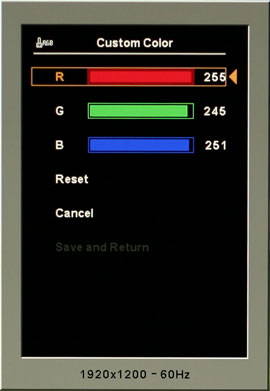
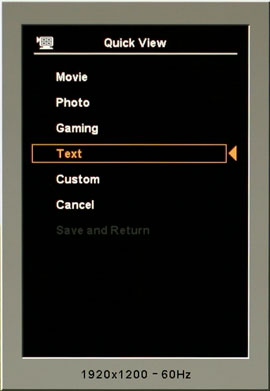


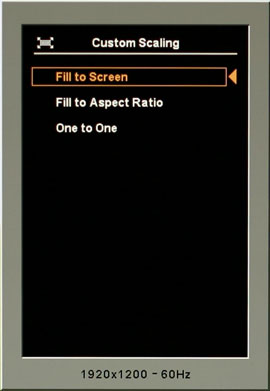
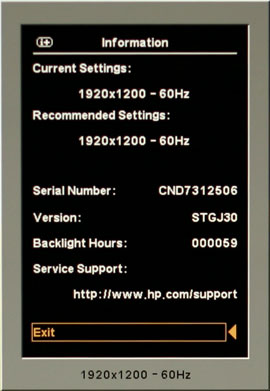










30 Comments
View All Comments
JarredWalton - Sunday, December 23, 2007 - link
It's partly an issue of getting enough reviews done so that more manufacturers are willing to work with us on monitor reviews. Things take time, and sometimes we go through periods where nothing new comes out for a while. I've got at least a few more LCDs coming shortly, and I hope many more post-CES will get sent our way for review.GlassHouse69 - Saturday, December 22, 2007 - link
IPS panels are the best for all things. some s-pva or mva's are close competitors to ips but still have colour errors and colour washout on angles over 20 degrees from center.tn panels shouldnt be priced higher than 350 dollars. one could get an almost 0 lag (15-19ms) 24" s-pva panel from LG and be more pleased for gaming and general use for 500 dollars.
i paid a grand for my 26" 1920x1200 H-IPS panel from planar. it is incredibly clear and accurate and has less than 1 frame lag. spending 550 dollars on a tn panel vs 900 dollars on a IPS pro fessional panel... sux cant see the point/value.
nevbie - Saturday, December 22, 2007 - link
Have you lurked in the xtknight's LCD thread at the forums?Perhaps you might get ideas about what people seek from reviews and what kind of LCDs they seek.
For me it seems that there are more interesting LCD models out there than reviews of LCDs. Pretty much the opposite situation when compared to GPUs or other less subjective review targets.
Anandtech LCD reviews seem a bit bare for me, as there are less measurements than in some other LCD review sites. It is difficult to say if reviewers at the other sites measure things that I would notice though, or if the extra measurements just generate artificial desires. Input lag measurements at behardware or RTC error measurements at xbitlabs are interesting, for example, but I don't know if I would be bothered by less than ideal results in actual use.
PS. The old comment system was better - no need to load/reload the article page when browsing comments.
9nails - Saturday, December 22, 2007 - link
What is "TN"?How about "S-PVA"?
Bonus question: How do the two differ / which is better?
JarredWalton - Saturday, December 22, 2007 - link
Well, I could try to explain it, but wikipedia already has a good deal of data on the matter. http://en.wikipedia.org/wiki/Thin_film_transistor_...">This Film TransistorsThe simple answer is that in my opinion:
S-IPS > S-PVA > S-TN/TN+Film
TN panels often have lower stated response times, but frankly I can't see the difference. I can however see the difference between the two in viewing angles and color quality.
trajan - Saturday, December 22, 2007 - link
I know it should go without saying (and usually does) but thanks for another great review that is so clearly unbiased. Just seems to me that if Anandtech is having a hard time getting manufacturers to send LCDs for review, handing out a negative article on the first offering is probably not going to encourage other manufacturers to follow suite. But the truth is the truth, and particularly after recent high profile events on other sites its nice to get a little reminder of the quality we can enjoy here.(This probably is coming across all doe-eyed fanboyish.. meh. It's just really nice to have trust worthy info sources)
KorruptioN - Friday, December 21, 2007 - link
The LG L246WP-BN is a P-MVA panel... it's beautiful and doesn't seem to exhibit some of the colour shifting that some PVA panels do. It'll be either that or Dell's next 24" for my next LCD.gochichi - Monday, December 24, 2007 - link
I recommend it at the $450.00 price tag. I own this display and I am very pleased with it overall. I vastly prefer the HDMI/DVI input as opposed to VGA on this particular display (some displays you literally can't tell the difference, not so on this panel).It is WORLDS better than the cheapish 24" Samsung. Samsung is building an overinflated name for itself... that or they are seriously risking their brand name over some "too good to be true" products (they really aren't good when you get them home).
I more than ever depend on review sites and user comments to help me navigate the sea of available products. I personally believe that the Dell is superior to the LG 24", however, the LG is more readily available at retail stores and a fantastic deal at $449.00.
agull22 - Friday, December 21, 2007 - link
I would like to see how HP plans to really markey this screen costing what it does and doing so litle for its return really. Right now though I am using my HP 42" Plasma as a monitor. I can honestly say it looks much nicer than the LCD equivalent. It would be nice to see something between the 42 and 26 size range though.LoneWolf15 - Friday, December 21, 2007 - link
$570? I paid around that price a year ago for a Dell 2407. I got an S-PVA panel, additional inputs (component, s-video), 9-in-1 card reader, 4 USB ports, and I got the five-year warranty.If HP thinks they can sell that panel for $570, they need to think again. 6-bit color, poorer viewing angle, limited inputs --you can do better for your money.